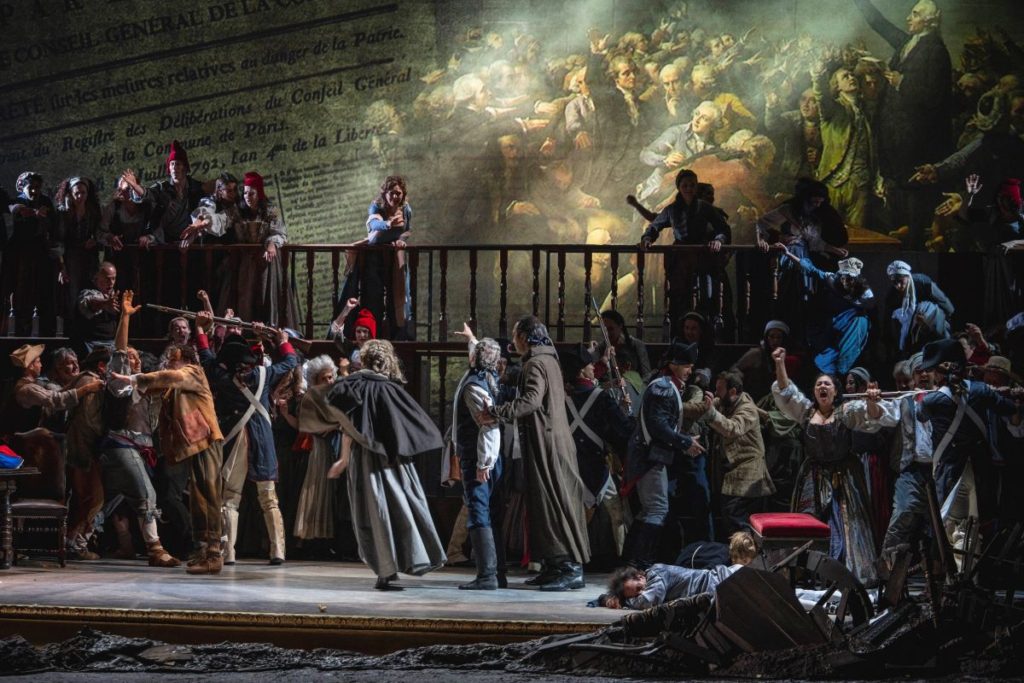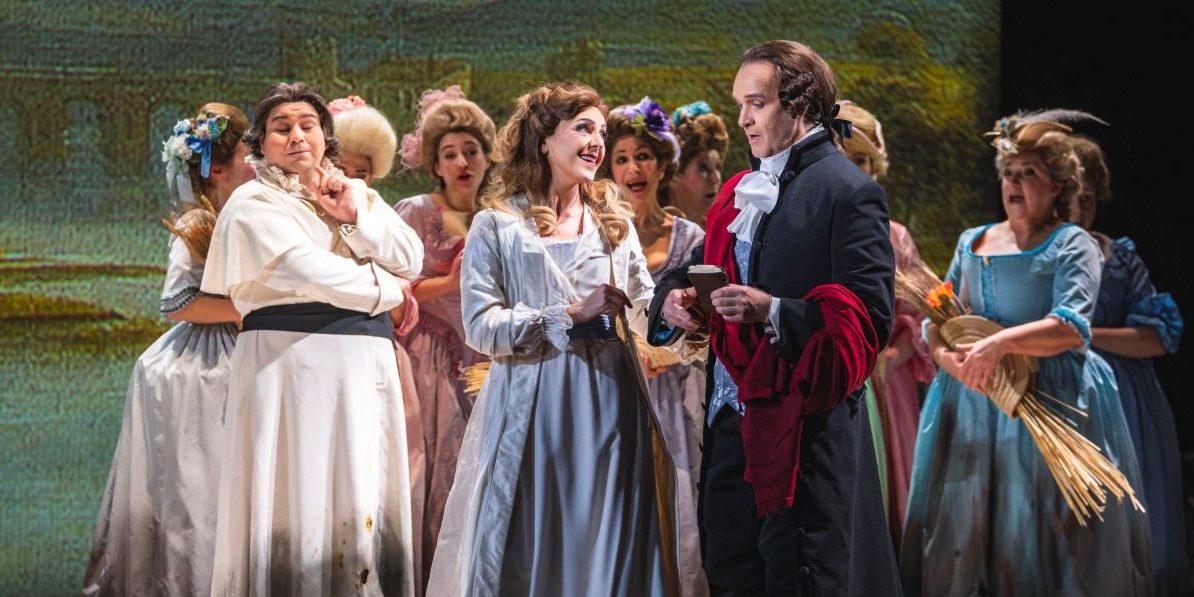Umberto Giordano used the true story of the poet Andrea Chénier, guillotined in 1794 aged 32, three days before the end of the Terror as inspiration for his opera.
This is the best production of this opera I have seen. Production, décor, costumes and especially the imaginative special effects by Nicolàs Boni were marvellously evocative of this horrific, cruel period in French history. Act I action takes place behind an oblique gilded frame leaning toward the unknown, the street in front covered in debris, signifying the dying aristocracy. Impressive special film effects dominate the back of the stage. Idyllic countryside behind the chateau in the first Act (reminiscent of Fragonard or Watteau) changes to the chateau burning as the Comtesse de Coigny crumples and burns with it. The second Act depicts more burning houses, brutal rape and murder behind a huge statue of Marat, Phyrigian bonnets, French flags and Marseilleise extracts. Moving on to the Tribunal scene which is dominated by Couder’s Serment du Jeu de paume. The Guillotine and prison dominate the final Act.

Conductor Marco Armiliato, is excellent in this repertoire, caressing the best out of orchestra and singers, makes full use of all the contrasts in the score and rich melodies with delicate phrasing.
Superstar Jonas Kauffman withdrew sick at short notice, replaced by the experienced German/Brasilian tenor, Martin Muehler. Hesitant in his opening aria –‘ un dì all’allurio spazio’, he settled down halfway through the first verse with the big phrase ‘gridai vinto d’amor…t’amo’. I would have liked more subtlety, more pianissimo, but his top notes were exciting and his Italian, excellent. Muehle occasionally approaches a note from below, giving intonation problems (a little out of tune), causing instability in the following phrase and loss of legato line as in the beginning eg of ‘come un bel dì di Maggio’. Nonetheless, it was an elegant, sensitive and intense performance.
Claudio Sgura’s baritone has a slightly rough quality, sometimes pushing top climaxes, but dominates the stage. His big voice suits the conflicted character of Gérard. His opening Act I aria – ‘compiacente a colloqui’, shows his disgust at being condemned to eternal suffering as servants with his descendants. ‘ T’odio casa dorata’ (I loathe this gilded house), he curses the guilty, lazy aristocrats, throwing over a large heavy table single-handed (his 6’6” frame useful here), and the powerful end of the aria foreshadows the terror to come – ‘é l’ora della morte. His baritone lacks a velvet quality, but makes up for it with a big voice, good breath control, well and warm tone. Act III, Gérard’s big scene – ‘Nemico della patria’ – was powerfully sung.
Puccini was renowned for ‘borrowing’; Gérard/Maddalena’s Act III scene is constructed similarly to Tosca Act II, written three years later. Both have powerful baritones lusting for the soprano, offering the life of the tenor love interest in exchange for sex, who dies anyway. Scarpia is evil: Gérard is decent and conflicted. Both sopranos sing moving arias pleading for mercy ‘la mamma morta’, / ‘vissi d’arte’.
Soprano Maria Agresta, indisposed last year for Manon Lescaut, (controversially replaced by Anna Netrebko), returned this year. Her full, expansive singing, and wonderful floated pianissimi top notes, with beauty of tone and complete control of her instrument are glorious. Her Act III aria, ‘la mamma morta’ describing her mother’s murder, is especially moving.
Fleur Barron’s warm mezzo gives an attractive performance as Bersi.
Manuela Custer’s rich mezzo delivers a stand out performance making the most of her two minutes as Madelon.
Tenor David Astorga, a minor role in Act I, gives a creepy performance of a priest more interested in his food (food stains over his costume), and fondling the aristocracy, than in religion.
Despite Kauffman’s absence, a second triumph for Queen Bartoli.

